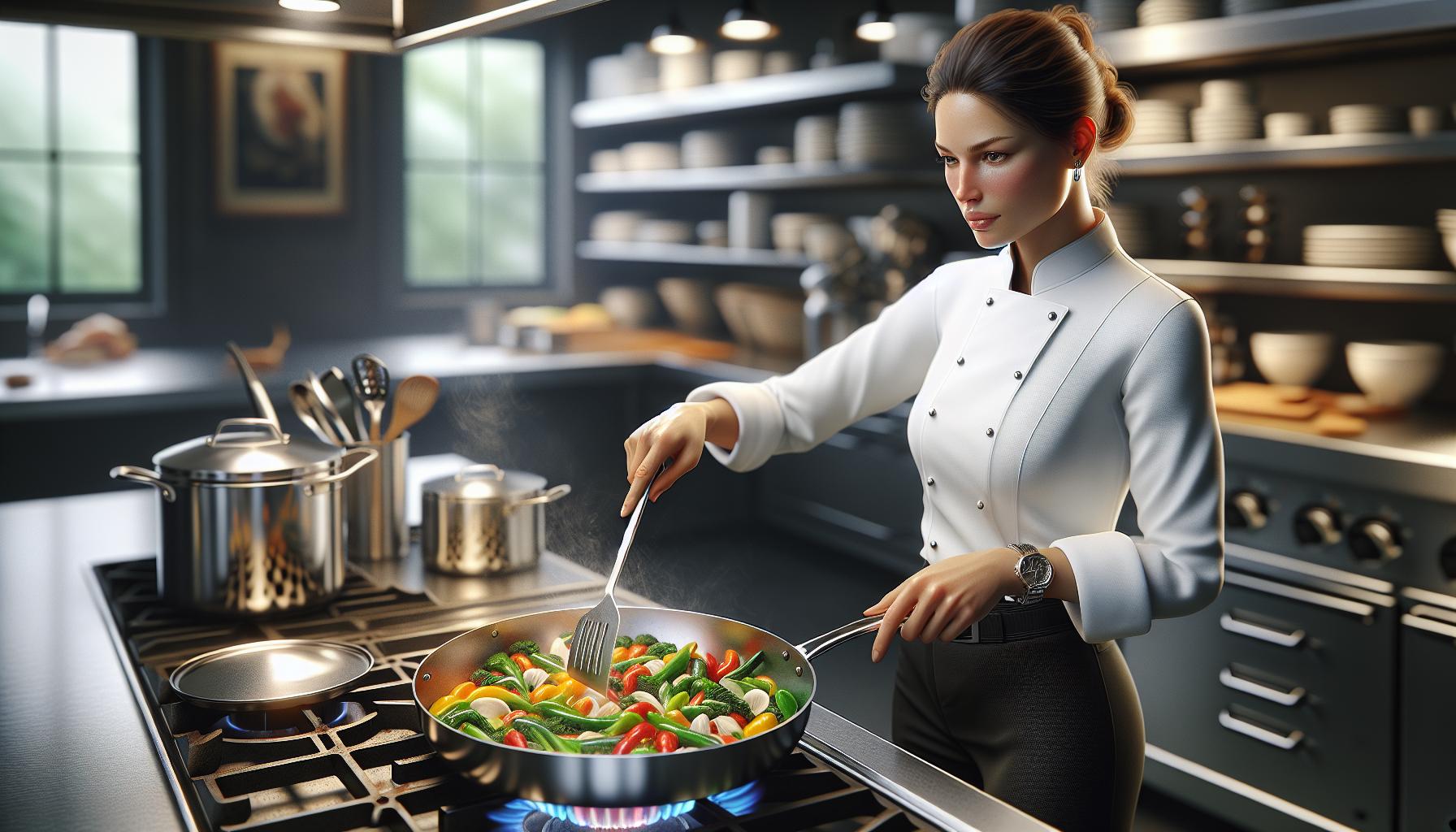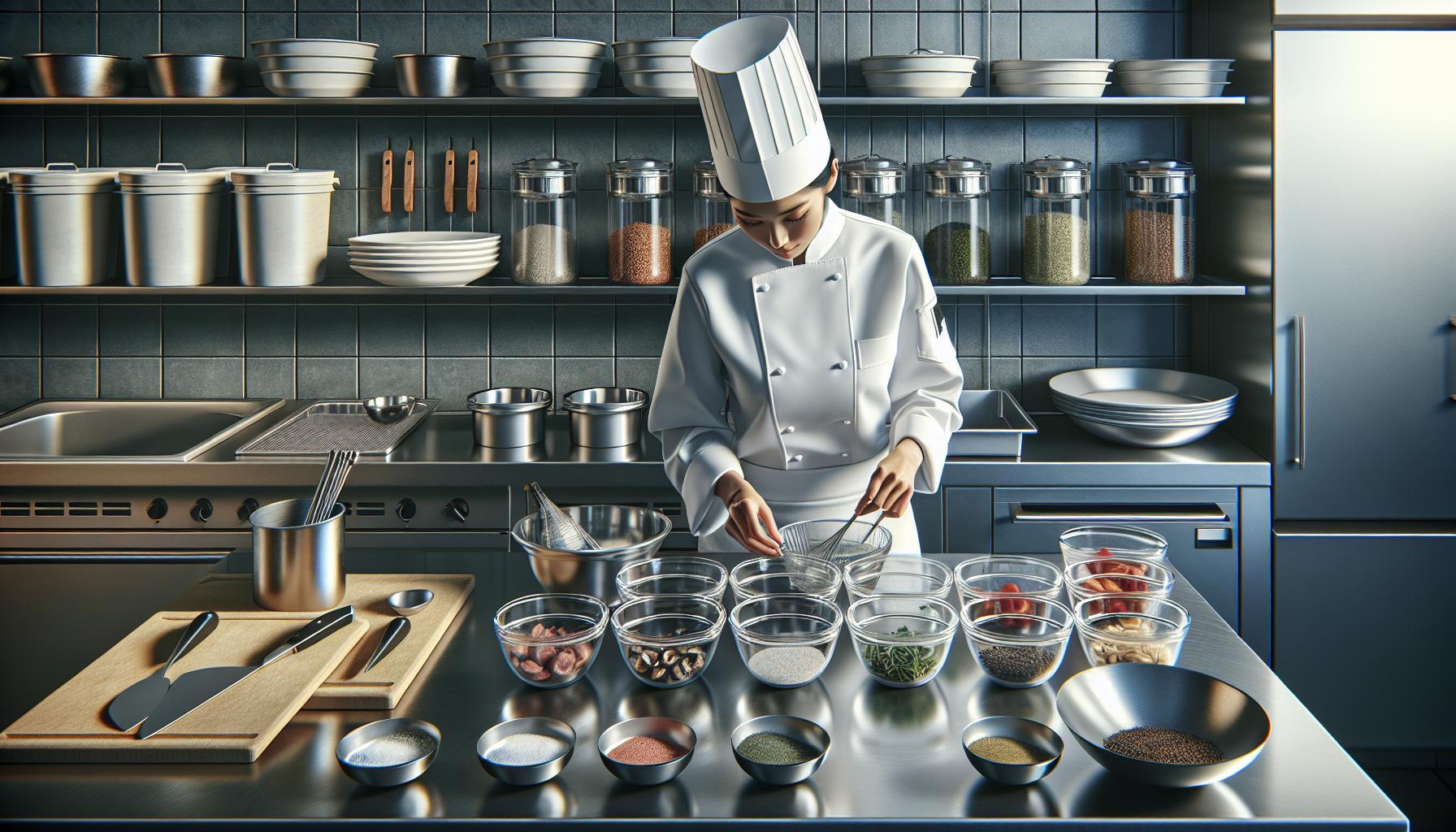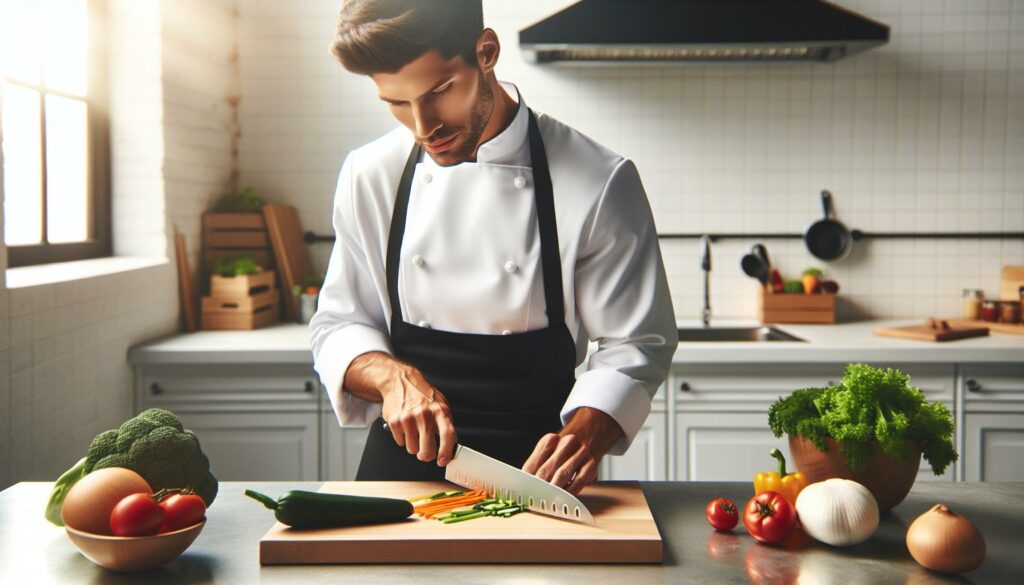Ever watched those celebrity chefs effortlessly slice, dice, and sauté their way through complex dishes? They make it look like child’s play while the rest of us struggle to boil water without setting off smoke alarms. But here’s a secret: professional cooking isn’t rocket science – it’s all about mastering the right techniques.
From knife skills that’ll make Gordon Ramsay proud to temperature control that’ll transform ordinary ingredients into extraordinary dishes professional cooking techniques are the building blocks of culinary excellence. Whether you’re a home cook looking to step up your game or an aspiring chef dreaming of restaurant stardom these essential skills will revolutionize your time in the kitchen.
Professional Cooking Techniques
Professional cooking equipment forms the foundation of an efficient kitchen operation. Each tool serves a specific purpose in creating consistent high-quality dishes at scale.
Must-Have Knives and Cutting Tools
A professional kitchen demands three essential knives: an 8-inch chef’s knife, a 4-inch paring knife and a 10-inch serrated bread knife. A chef’s knife handles 90% of cutting tasks, from chopping vegetables to breaking down proteins. Paring knives excel at intricate tasks like deveining shrimp, peeling fruit or creating garnishes. Serrated knives cut through crusty breads, soft fruits and delicate pastries without crushing.
Supporting tools include:
- Sharpening stone and honing steel for blade maintenance
- Heavy-duty kitchen shears for butchering poultry
- Precision bench scraper for ingredient transfer
- Microplane grater for zesting citrus and grating hard cheese
- Mandoline slicer for uniform vegetable cuts
Commercial-Grade Cookware
Professional kitchens rely on specific cookware materials for optimal heat distribution and durability. Copper core stainless steel pans offer superior temperature control. Cast iron skillets create the perfect sear on proteins. Heavy-gauge aluminum stockpots conduct heat evenly for soups and stocks.
- 10-inch and 12-inch sauté pans with lids
- 2-quart and 4-quart saucepans
- 8-quart stockpot for bulk cooking
- Cast iron skillet for high-heat searing
- Sheet pans in full and half sizes
- Non-stick pans for eggs and delicate items
Mastering Knife Skills

Knife skills form the cornerstone of professional cooking techniques. Precise cutting enhances food presentation creates uniform cooking times through consistent sizes.
Proper Knife Grip and Control
Professional chefs utilize a pinch grip technique to maximize control over the knife blade. The thumb grasps one side of the blade while the index finger wraps around the opposite side creating stability. The remaining three fingers curl around the handle maintaining balance during cutting motions. This grip enables chefs to direct force through the blade’s center point increasing accuracy for delicate cuts. A relaxed wrist allows fluid movement reducing hand fatigue during extended prep sessions.
Basic Cutting Techniques
Professional kitchens employ five essential cutting techniques: dicing julienne chiffonade brunoise slicing. Dicing creates uniform cubes ranging from 1/4 inch to 3/4 inch perfect for soups stews sautés. Julienne cuts produce matchstick-sized strips measuring 1/8 inch by 2 inches ideal for garnishes stir-fries salads. Chiffonade involves rolling leafy herbs into tight cylinders then slicing them into thin ribbons. Brunoise consists of 1/8-inch cubes used in fine dining presentations sauces. Slicing techniques vary based on ingredients thickness requirements ranging from paper-thin carpaccio cuts to substantial protein portions.
Temperature Control and Heat Management

Professional cooking requires precise temperature control to achieve consistent, high-quality results. Managing heat effectively transforms ingredients into perfectly cooked dishes while maintaining their texture, flavor and nutritional value.
Understanding Heat Zones
Heat zones form distinct temperature areas on cooking surfaces that enable multiple cooking techniques simultaneously. A professional gas range creates three primary heat zones: high (500°F+), medium (300-400°F) and low (200-300°F). The center of the pan generates the hottest temperatures, while the outer edges maintain lower heat levels. Chefs utilize these zones for specific purposes:
- Searing meats occurs in high-heat zones for optimal caramelization
- Sautéing vegetables requires medium heat for even cooking
- Delicate sauces simmer in low-heat areas to prevent separation
- Pan corners serve as resting spots to regulate ingredient temperatures
Pan Temperature Mastery
Pan temperature control starts with selecting appropriate cookware for each cooking method. Heavy-bottomed pans made of copper or multi-clad stainless steel provide superior heat distribution. Professional chefs test pan readiness through these methods:
- Water droplet test: Drops form perfect beads at 350-375°F
- Hand test: Palm held 6 inches above indicates temperature range
- Oil sheen: Rippling surface shows 350-400°F for frying
- Color changes: Oil turns honey-colored at optimal cooking temperature
| Cooking Method | Temperature Range |
|---|---|
| Searing | 400-450°F |
| Sautéing | 320-375°F |
| Pan Frying | 350-375°F |
| Gentle Cooking | 250-300°F |
Professional Food Preparation Methods

Professional food preparation relies on systematic approaches to transform raw ingredients into refined dishes. These methods encompass organized workspace management and precise ingredient processing techniques.
Mise en Place Organization
Mise en place forms the cornerstone of professional kitchen efficiency through systematic ingredient organization. Chefs arrange prepared ingredients in clear glass bowls or stainless steel containers based on their cooking sequence. A standard mise en place setup includes:
- Prepped ingredients grouped by cooking stage
- Pre-measured seasonings in portion cups
- Organized tools at designated workstation spots
- Clean kitchen towels for immediate use
- Sanitized cutting boards positioned strategically
- Recipe components arranged in order of use
Professional kitchens maintain specialized mise en place stations for different cooking methods:
| Station Type | Key Components |
|---|---|
| Sauté Station | Oils, aromatics, proteins |
| Grill Station | Marinades, seasonings, proteins |
| Garde Manger | Fresh produce, garnishes, dressings |
Ingredient Processing Techniques
Professional kitchens employ specific techniques to process ingredients for optimal flavor development. Raw ingredients undergo precise preparation methods:
- Blanching vegetables in salted water for 30-60 seconds
- Brining proteins in 6% salt solution for 1-4 hours
- Marinating meats with acid-based mixtures for 2-8 hours
- Grinding spices immediately before use
- Clarifying stocks through repeated straining
- Processing herbs through shock-cooling methods
| Process | Temperature Range |
|---|---|
| Quick Blanching | 185-205°F |
| Herb Shocking | 32-34°F |
| Spice Toasting | 300-325°F |
| Stock Simmering | 180-200°F |
Advanced Cooking Methods
Professional chefs employ sophisticated cooking techniques to maximize flavor development while maintaining ingredient integrity. Each method serves specific culinary purposes based on the ingredients’ characteristics.
Dry-Heat Cooking Techniques
Professional kitchens utilize dry heat methods at temperatures between 300-500°F (149-260°C) to create complex flavors through browning reactions. Broiling delivers intense top-down heat for achieving caramelized exteriors on proteins like steaks or fish fillets. Pan-searing creates a flavorful crust by cooking ingredients in a minimal amount of fat at high temperatures. Roasting enhances natural flavors through even heat distribution in an enclosed oven environment. Deep-frying immerses ingredients in 350-375°F (177-191°C) oil to achieve crispy exteriors while maintaining moisture inside.
| Dry-Heat Method | Temperature Range | Best Applications |
|---|---|---|
| Broiling | 500°F/260°C | Steaks, Fish |
| Pan-searing | 400-450°F/204-232°C | Proteins, Vegetables |
| Roasting | 300-450°F/149-232°C | Meats, Root Vegetables |
| Deep-frying | 350-375°F/177-191°C | Breaded Items, Chips |
Moist-Heat Cooking Applications
Moist heat methods use water-based liquids to transfer heat while preserving moisture content in ingredients. Braising combines initial searing with slow cooking in liquid at 200-250°F (93-121°C) to tenderize tough cuts of meat. Steaming preserves nutrients by cooking ingredients with hot vapor at 212°F (100°C). Poaching gently cooks delicate items like eggs or fish in liquid maintained at 160-180°F (71-82°C). Sous vide cooking precisely controls temperature by immersing vacuum-sealed ingredients in water baths set to exact temperatures.
| Moist-Heat Method | Temperature Range | Best Applications |
|---|---|---|
| Braising | 200-250°F/93-121°C | Tough Meats |
| Steaming | 212°F/100°C | Vegetables, Fish |
| Poaching | 160-180°F/71-82°C | Eggs, Delicate Fish |
| Sous Vide | 130-185°F/54-85°C | Proteins, Vegetables |
Kitchen Safety and Sanitation
Professional kitchens maintain strict safety protocols to prevent accidents and ensure food safety. Proper sanitation practices protect both staff and customers while meeting health department regulations.
Food Safety Standards
Food safety depends on maintaining proper temperatures throughout storage and preparation. Professional kitchens store raw meats below 40°F (4°C) and cooked foods above 140°F (60°C) to prevent bacterial growth in the danger zone. Cross-contamination prevention requires separate cutting boards, color-coded for proteins, produce and ready-to-eat items. The FDA mandates handwashing stations, sanitizing solutions at specific concentrations and regular temperature monitoring of refrigeration units. Health codes require food handlers to wear proper attire including closed-toe shoes, hair restraints and clean uniforms. Regular cleaning schedules document sanitation of all food contact surfaces, equipment and storage areas.
Workspace Organization
An organized workspace maximizes efficiency and minimizes safety hazards in professional kitchens. Designated stations keep raw ingredients separate from prepared foods through clear zones marked on countertops. Storage shelves follow a top-down arrangement with ready-to-eat items above raw ingredients. Equipment placement creates clear traffic patterns that prevent collisions between staff members. Anti-fatigue mats line walkways to reduce slip hazards while providing comfort during long shifts. Emergency equipment including fire extinguishers, first aid kits and eye wash stations remain easily accessible. Written protocols posted at each station outline cleaning procedures, safety guidelines and proper equipment operation steps.
Plating and Presentation Skills
Professional plating transforms dishes from mere sustenance to visual masterpieces. The art of food presentation combines color theory placement techniques balance to create memorable dining experiences.
Basic Plating Principles
Professional chefs follow five fundamental plating principles to create visually appealing dishes. The rule of thirds divides plates into a 3×3 grid placing focal points at intersecting lines. Odd-number groupings of elements create visual interest through asymmetry. Color combinations enhance appeal with complementary hues such as orange carrots against green herbs. Height variation adds dimension through stacking or layering components at different levels. White space management frames the dish by leaving 20-30% of the plate empty creating a canvas-like effect.
Garnishing Techniques
Garnishing elevates dishes through strategic placement of edible decorative elements. Micro greens add delicate texture color when scattered across protein dishes. Herb oils create artistic swirls sauces dots using squeeze bottles for precision. Edible flowers like nasturtiums pansies violas provide pops of color seasonal appeal. Citrus segments bring brightness through careful supreming of oranges lemons. Spun sugar towers add dramatic height to dessert plates while candied nuts provide textural contrast. Professional garnishing incorporates elements that complement both the visual presentation flavor profile of the dish.
Exceptional Dining Experiences
Professional cooking techniques represent a blend of artistry precision and scientific understanding. Mastering these skills transforms ordinary cooking into extraordinary culinary experiences that delight both the palate and eyes. From proper knife skills to temperature control and from mise en place to advanced plating techniques these fundamental principles form the backbone of professional cooking.
Armed with the right knowledge tools and techniques any dedicated cook can elevate their culinary skills to professional levels. The journey to mastery requires practice patience and a commitment to maintaining the highest standards of both creativity and safety in the kitchen. Those who embrace these principles will find themselves well-equipped to create exceptional dining experiences that rival those found in professional kitchens.

